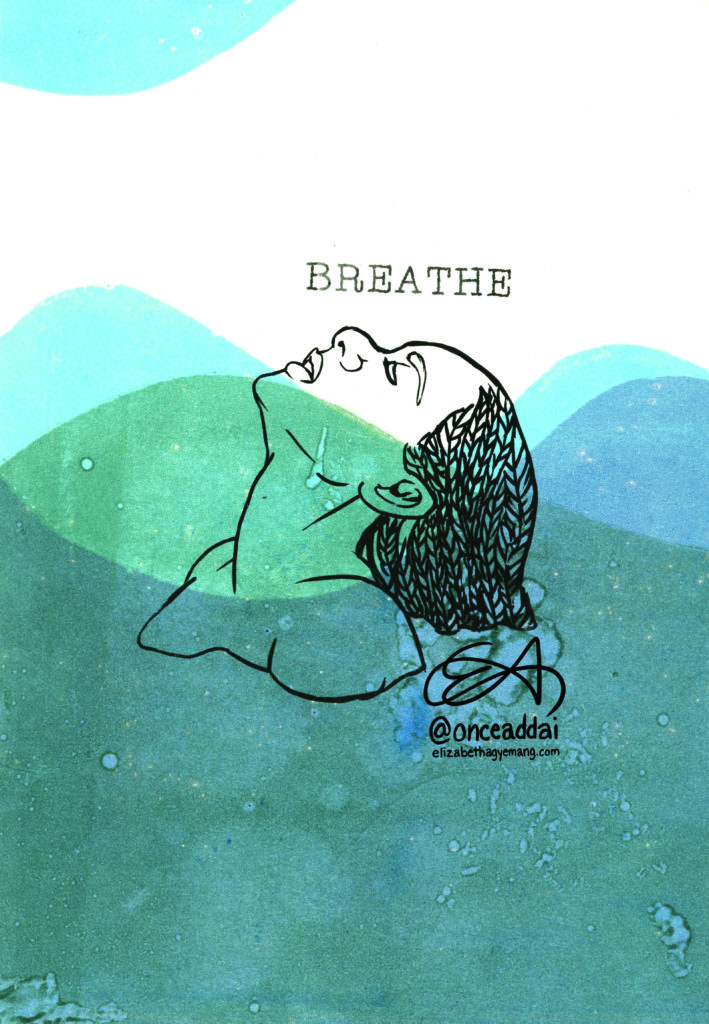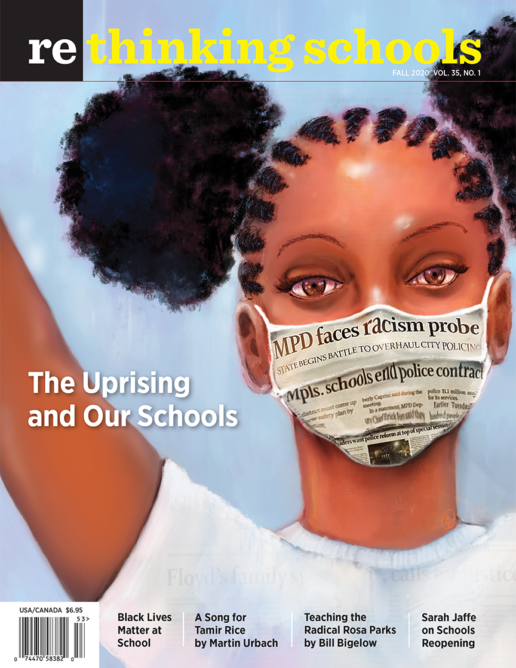Say Their Names
Illustrator: Elizabeth Agyemang
“I can’t breathe . . . please . . . Mama!”
The knee choking the neck to death
Police hands in pockets and
Indifferent expressions
Another day on the J-O-B
And more
More details I can never unsee
The stream of urine trickling
Slowly
The hooded looks
Weapons ready
To keep help at bay
Everyone waiting
Waiting
For the silence that came
Eight minutes and 46 seconds later.
This one hit different.
Hours upon hours of being indoors
With nothing to do
But watch the news
See what’s the latest
This broke the floodgates open.
I sat reading
email after email
text after text
post after post.
I thought of my family: my husband, sons, and friends.
I cried.
I ranted.
I hugged my loved ones close.
I sought comfort from those who understood my pain
And whose pain I understood.
I kept my circle small.
And then work the next day.
The weight of responsibility as a teacher weighed me down.
What should I do now?
How will what I do be received?
What is my responsibility?

In my own emotional turmoil and exhaustion I wasn’t sure what I could do that would be enough. We weren’t even in the classroom. Parents hovered and had power over what their kids learned differently than before quarantine. When my students logged in for small group class time, parents were there to assist. Parents listened to me read the math problem or watched with the students as I taught the writing prompt, and then helped their kids complete their work. In a normal classroom, this would be an autonomous time for students, or time with the teacher getting help. As their kindergarten teacher, I was no longer the primary adult of their daytime, but my students loved me like I still was. That safe warm spot they created for me to be in their lives was still a part of them and they would be ready for me and whatever I gave to them.
I thought about all of the ways that I worked to infuse positive images about Black being beautiful into the school year: visual imagery on the walls, hundreds of books with Black and Brown characters and story lines, Black Lives Matter Week of Action lessons where we learned words like equality, equity, liberty, justice. We had daily social problem-solving, working to create white allies who will include, and also step in and help our friends who are the “only” of their race or ethnicity in the class. I thought of all of this and I knew that my class could handle this lesson, this gesture, our initial stand with those of us hurting in our school community.
This time, I needed to go through parents and their differing interpretations of what they thought the lesson was about in order for my students to complete it, so I tried to be clear when I wrote a simple lesson. I used a name art lesson from a unit that we did in the beginning of the school year when we introduced ourselves to the classroom community. This was a lesson where they used symbols and fancy lettering to express themselves and their names.
The lesson they would see on their online class assignment page read: Say Their Names.
Sunshines,
We have talked and created about Black being beautiful. We have learned that not everyone sees Black as greatness, and we created poems to show everyone how important and special Black culture and people are to us. Recent events have led to sad, tired, and angry Black families and communities because so many Black men and women have been killed by police and other white people who do not agree with us. So let’s do the work! Let’s make signs and hang them in our windows so everyone walking by can see. Let’s write and decorate in the most beautiful ways, the names of the Black people who were killed. Let’s make signs so the tired and hurt families can see them and know that we are on the same team! Let’s convince our neighbors the beauty of those we lost. Let’s show that Black lives matter! Let’s never forget their names.
1. Choose one (or all) of these names to decorate: George, Breonna, Ahmaud. You can make bubble letters, swirly letters, block letters, tall letters. You decide what you think will look the best.
2. Use the colors you love a lot and colors others love a lot, and decorate the names with patterns and designs that you love.
3. (Optional) Choose powerful words to decorate with too! Here are some examples of powerful words: Justice, Peace, Love, Rights.
4. Trace over the name one last time to make sure it stands out.
Remember, we want people to see the beauty of these names. Take your time and do your best.
I knew it was a small step, but in my emotional state, it was what I had to give. As the only Black teacher at my school, and one of five Black staff members in the building, I have a range of negative experiences at work. There is something I don’t want to be in this time: the only reference for white teachers for what to do.
And also this: I don’t want to be the person they check on because the district said “Check on your Black colleagues.” I want authentic interactions and inquiries.
I don’t want to give my opinion about how they go about educating themselves during their “awakening” of Black lives mattering. I am grieving and angry and tired and I want to know there are allies in my midst.
I don’t want to be called upon to create an environment that is inclusive and welcoming because it’s what I have been doing this whole time. They didn’t see it, and when I quietly invited them, they didn’t join me.
But also this: I don’t want to feel alone all the time.
I want white teachers to do the work, starting from where they are at in their own journeys. I am in a different place and they are not with me. A resource? Sure. Hand over what I’ve done or created? No, thanks.
I want white teachers to diversify their curriculum and invite our Black and Brown children into learning on completely different levels than in the past. The status quo didn’t change because teachers didn’t change their perspective or approach. One or two lessons, although a start, is not enough.
I want white teachers to question themselves and their craft of teaching, to take risks and join in the building of a new reality of learning for Black and Brown students, one that does not end up in prison as a result of the pipeline that educators contribute to.
I want white teachers to make the time for us, the Black community, in their work space and curriculum.
After George Floyd’s murder, a few white parents emailed me and two acknowledgements stood out.
One parent wrote, “I am so saddened and also realizing how much I need to educate myself, do the work, get uncomfortable, and not just feel sad.” She realized there was work to be done.
Another parent said, “I know it’s not your job to teach me how to be a better white person or a better white parent, but I will continue to look for lessons in your words. Thank you.”
That’s what I needed.
To know I am seen.
To know I am valued.
To know I matter.
Kara Hinderlie Stroman (karahinderlie@gmail.com) teaches kindergarten at Irvington School in Portland, Oregon. Her article “Black Is Beautiful” (fall 2017 issue of Rethinking Schools) appears in the book Teaching for Black Lives.
Illustrator Elizabeth Agyemang is represented by New Leaf Literary & Media. The artwork is used with permission. ©Elizabeth Agyemang. All rights reserved.

